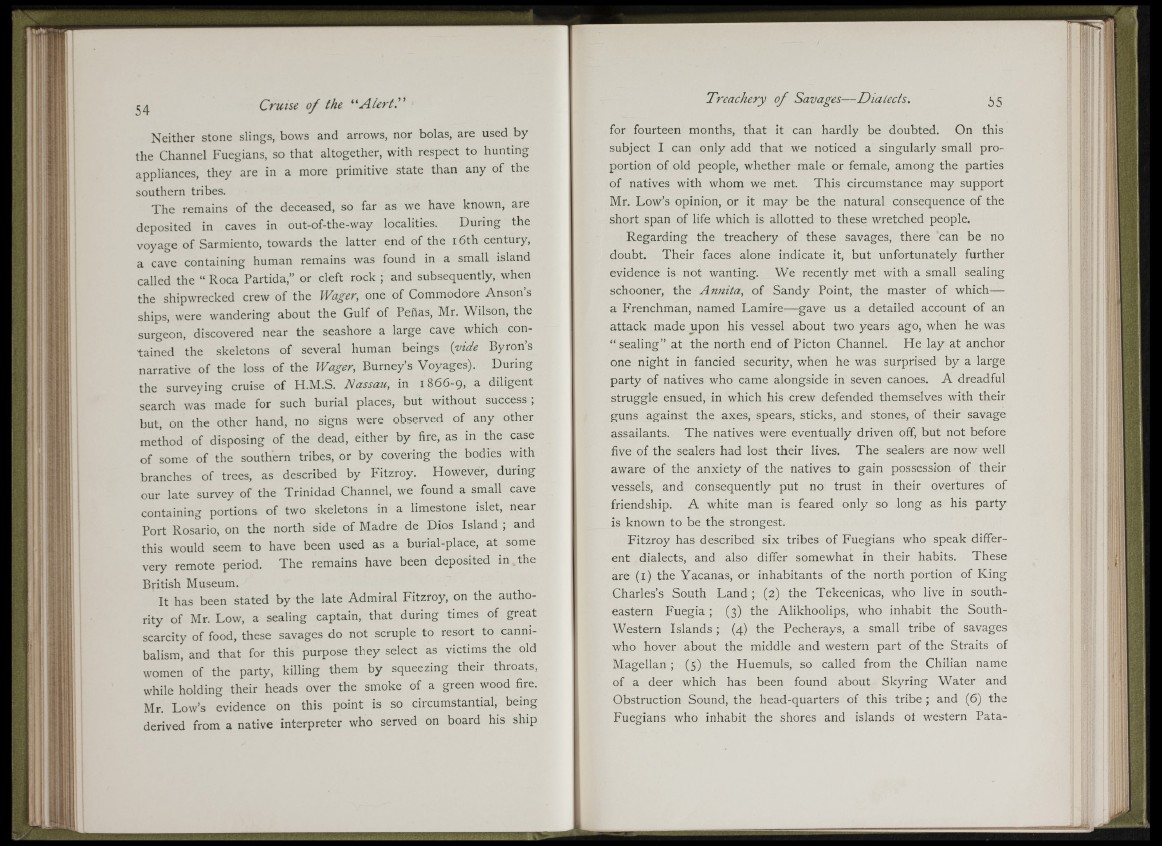
Ti!;
(I
a
54 Cruise of the “ Alert.”
Neither stone slings, bows and arrows, nor bolas, are used by
the Channel Fuegians, so that altogether, with respect to hunting
appliances, they are in a more primitive state than any of the
southern tribes.
The remains of the deceased, so far as we have known, are
deposited in caves in out-of-the-way localities. During the
voyage of Sarmiento, towards the latter end of the 16th century,
a cave containing human remains was found in a small island
called the “ Roca Partida,” or cleft rock ; and subsequently, when
the shipwrecked crew of the Wager, one of Commodore Anson’s
ships, were wandering about the Gulf of Peñas, Mr. Wilson, the
surgeon, discovered near the seashore a large cave which contained
the skeletons of several human beings f id e Byron’s
narrative of the loss of the Wager, Burney’s Voyages). During
the surveying cruise of H.M.S. Nassau, in 1866-9, a diligent
search was made for such burial places, but without success ;
but, on the other hand, no signs were observed of any other
method of disposing of the dead, either by fire, as in the case
of some of the southern tribes, or by covering the bodies with
branches of trees, as described by Fitzroy. However, during
our late survey of the Trinidad Channel, we found a small cave
containing portions of two skeletons in a limestone islet, near
Port Rosario, on the north side of Madre de Dios Island ; and
this would seem to have been used as a burial-place, at some
very remote period. The remains have been deposited in.the
British Museum.
It has been stated by the late Admiral Fitzroy, on the authority
of Mr. Fow, a sealing captain, that during times of great
scarcity of food, these savages do not scruple to resort to cannibalism,
and that for this purpose they select as victims the old
women of the party, killing them by squeezing their throats,
while holding their heads over the smoke of a green wood fire.
Mr. Low’s evidence on this point is so circumstantial, being
derived from a native interpreter who served on board his ship
Treachery of Savages— Dialects. 55
for fourteen months, that it can hardly be doubted. On this
subject I can only add that we noticed a singularly small proportion
of old people, whether male or female, among the parties
of natives with whom we met. This circumstance may support
Mr, Low’s opinion, or it may be the natural consequence of the
short span of life which is allotted to these wretched people.
Regarding the treachery of these savages, there can be no
doubt. Their faces alone indicate it, but unfortunately further
evidence is not wanting. We recently met with a small sealing
schooner, the Annita, of Sandy Point, the master of which—
a P'renchman, named Lamire— gave us a detailed account of an
attack made upon his vessel about two years ago, when he was
“ sealing” at the north end of Picton Channel. He lay at anchor
one night in fancied security, when he was surprised by a large
party of natives who came alongside in seven canoes. A dreadful
struggle ensued, in which his crew defended themselves with their
guns against the axes, spears, sticks, and stones, of their savage
assailants. The natives were eventually driven off, but not before
five of the sealers had lost their lives. The sealers are now well
aware of the anxiety of the natives to gain possession of their
vessels, and consequently put no trust in their overtures of
friendship. A white man is feared only so long as his party
is known to be the strongest.
Fitzroy has described six tribes of Fuegians who speak different
dialects, and also differ somewhat in their habits. These
are (l) the Yacanas, or inhabitants of the north portion of King
Charles’s South Land ; (2) the Tekeenicas, who live in southeastern
Fuegia; (3) the Alikhoolips, who inhabit the South-
Western Islands ; (4) the Pecherays, a small tribe of savages
who hover about the middle and western part of the Straits of
Magellan ; (5) the Huemuls, so called from the Chilian name
of a deer which has been found about Skyring Water and
Obstruction Sound, the head-quarters of this tribe ; and (6) the
Fuegians who inhabit the shores and islands oi western Pata-
L-ílf
[